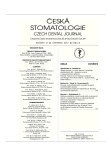Fluoride Content in the Nutrition of Infants and Younger Preschool Children – Instant Baby Food Products
Authors:
E. Oganessian; Z. Broukal
Authors‘ workplace:
Ústav klinické a experimentální stomatologie 1. LF UK a VFN, Praha
Published in:
Česká stomatologie / Praktické zubní lékařství, ročník 112, 2012, 4, s. 95-99
Category:
Original Article – Retrospective Essay
Overview
Aim:
The aim of this study was to analyze the fluoride content in instant baby food products, available in the consumer basket of the network of pharmacies and grocery stores and provide dental public data necessary for to competent preventive food counselling.
Material and Methods:
The study was performed on four sets of instant baby food and snacks from manufacturers Hero, Nutricia, Hipp and Humana. The analysis was carried out by potentiometric titration using fluoride ion selective electrode after the quantitative fluoride extraction by the immuno-diffusion method facilitated by perchloric acid and hexamethyldisiloxane. Four sets of products instant baby food were measured including cereal porridges, vegetable soups and baby side dishes, instant meat-vegetable meals and fruit snacks.
Results:
Fluoride content in all analyzed food products was low in the range from 0.14 to 0.56 mg/1000 ml, thus representing per usual packaging 0.03 to 0.12 mg/200 g.
The estimated fluoride intake from instant food from one to two packs a day could share in total daily intake of fluoride in younger and older preschool children by about 25–30 and 17–20% respectively.
Conclusion:
With an average low intake of food borne fluoride in our children, which is below the accepted optimum range it is not necessary to consider the instant baby food as a significant source of fluoride and take it into account in the balance sheet indicating use of fluoride tablets.
Key words:
fluorides – child nutrition – preschool age
Sources
1. COMMISSION REGULATION (EC) No 1925/ 2006 OF THE EUROPEAN PARLIAMENT AND OF THE COUNCIL of 20 December 2006 on the addition of vitamins and minerals and of certain other substances to foods. Official J. Eur. Union, L404, 2006, s. 26-37. http://eur-lex.europa. eu/LexUriServ/LexUriServ.do?uri=OJ:L:2006:404:0026:0038:EN:PDF.
2. COMMISSION REGULATION (EC) No 953/ 2009 of 13 October 2009 on substances that may be added for specific nutritional purposes in foods for particular nutritional uses. Official Journal of the European Union, L262, 2009, s. 9-19. http://eur-lex.europa.eu/LexUriServ/ LexUriServ.do?uri=OJ:L:2009:269:0009:0019:EN:PDF.
3. EFSA: Opinion of the Scientific Panel on Dietetic Products, Nutrition and Allergies on a request from the Commission related to the Tolerable Upper Intake Level of Fluoride. http://www.efsa.europa.eu/en/scdocs/doc/s192.pdf.
4. Erdal, S., Buchanan, S. N.: A quantitative look at fluorosis, fluoride exposure, and intake in children using a health risk assessment approach. Environmental Health Perspectives, roč. 113, 2005, s. 111–117.
5. Guha-Chowdhury, N., Drummond, B. K., Smillie, A. C.: Total fluoride intake in children aged 3 to 4 years-a longitudinal study. J. Dent. Res., roč. 75, 1996, s. 1451–1457.
6. Heilman, J. R., Kiritsy, M. C., Levy, S. M., Wefel, J. S.: Fluoride concentrations of infant foods. J. Am. Dent, Assoc., roč. 128, 1997, s. 857–863.
7. Martínez-Mier, E. A., Soto-Rojas, A. E., Ureña-Cirett, J. L., Stookey, G. K., Dunipace, A. J.: Fluoride intake from foods, beverages and dentifrice by children in Mexico. Community Dent. Oral Epidemiol., roč. 31, 2003, s. 221–230.
8. Oganessian, E., Ivančaková, R., Koštířová, M., Broukal, Z.: Obsah fluoridu v balených kojeneckých, pramenitých a přírodních minerálních vodách. Čes. Stomat., roč. 107, 2007, s. 32–35.
9. Oganessian, E., Broukal, Z., Lenčová, E., Ivančaková, R., Dušková, J.: Obsah fluoridu v produktech instantní mléčné výživy kojenců a batolat. Čes. Stomat., roč. 108, 2008, s. 87–90.
10. Oganessian, E., Ivancakova, R., Lencova, E., Broukal, Z.: Alimentary fluoride intake in preschool children. BMC Public Health, roč. 11, 2011, s. 768.
11. Pagliari Tiano, A. V., Moimaz, S. A., Saliba, O., Saliba, N. A., Sumida, D. H.: Fluoride intake from meals served in daycare centres in municipalities with different fluoride concentrations in the water supply. Oral Health Prev. Dent., roč. 7, 2009, s. 289–295.
12. Taves, D. R.: Separation of fluoride by rapid diffusion using hexamethyldisiloxane. Talanta, roč. 15, 1978, s. 969–974.
13. Van Winkle, S., Levy, S. M., Kiritsy, M. C., Heilman, J. R., Wefel, J. S., Marshall, T.: Water and formula fluoride concentrations: significance for infants fed formula. Pediatr. Dent., roč. 17, 1995, s. 305–310.
14. Weyessa Gari, D., Kožíšek, F.: Zpráva o kvalitě pitné vody v ČR za rok 2010. Státní zdravotní ústav, Praha, s. 40. http://www.szu.cz/uploads/ documents/chzp/voda/pdf/monit/voda_10.pdf.
15. WHO child growth standards and the identification of severe acute malnutrition in infants and children; WHO, Geneva, 2009; http:// www.who.int/childgrowth/standards/weight_for_age/en/index.html.
Labels
Maxillofacial surgery Orthodontics Dental medicineArticle was published in
Czech Dental Journal

2012 Issue 4
Most read in this issue
- A Contemplation about the Importance of Prosthetic Defect Classification Systems in Contemporary Dentistry
- Analysis of Deciduous and Permanent Teeth of Children from Brno of 1–15 years of Age with the Focus on Frequency of Dental Caries and Teeth Eruption
- Bond Strength of Adhesive Materials for Bonding of Orthodontic Brackets
- Fluoride Content in the Nutrition of Infants and Younger Preschool Children – Instant Baby Food Products
